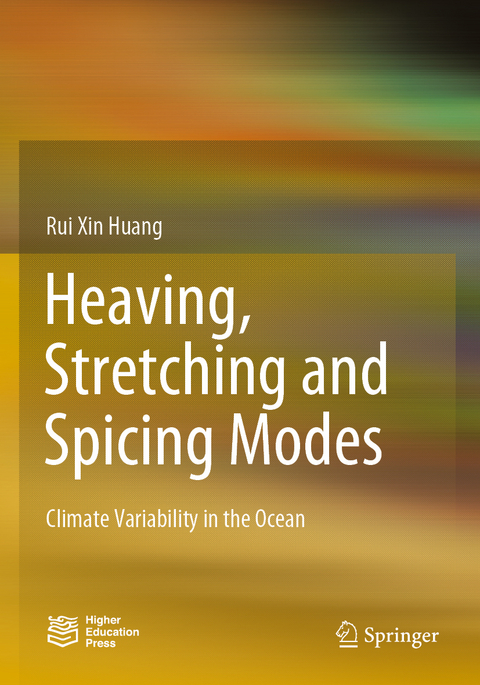
Heaving, Stretching and Spicing Modes
Springer Verlag, Singapore
978-981-15-2943-6 (ISBN)
In addition to the traditional Theta-S diagram, the sigma-pi (potential density – potential spicity) diagram can also be used in analyzing water mass property distribution and climatevariability.
This book is focused on fundamental aspects of climate variability in the ocean, in particular changes of the wind-driven circulation. The vertical movement of isopycnal (isothermal) layers, including their stretching and compression, is called heaving and stretching. A major part of climate variability in the ocean is heaving in nature. Heave is primarily associated with the adiabatic motions of isopycnal layers due to change of wind stress. It is rather difficult to separate the contributions from adiabatic and diabatic processes.
Isopycnal analysis has been widely used in climate study; however, it is much more accurate to study the isopycnal layers. Here climate signals are examined in terms of changes of layer depth, layer thickness, layer temperature/salinity, spicity and others.
In addition to the traditional Theta-S diagram, the sigma-pi (potential density – potential spicity) diagram can also be used in analyzing water mass property distribution and climatevariability. In fact, a radius of signal can be defined rigorously for signals in the sigma-pi diagram; the combination of isopycnal analysis and evaluation of radius of signal provides a powerful tool in analyzing climate variability in the world oceans.
Rui Xin Huang is Scientist Emeritus of the Woods Hole Oceanographic Institution. He has been engaged in oceanic and climatic research for more than 3 decades. His research interests are theoretical and numerical studies of the wind-driven and thermohaline circulation in the oceans, dynamics of western boundary currents, flow over topography, climate and paleoclimate dynamics.
Basic concepts.- Climate variability diagnosed in spherical coordinates.- Climate variability diagnosed in z-coordinate.- External/internal modes in meridional/zonal directions.- Adiabatic signals in the upper ocean.- The regulation of MOC (MHF) by wind stress and buoyancy anomaly.- Adiabatic Heaving signals in the deep ocean.- Heaving, stretching, spicing and isopycnal analysis.- Heaving, stretching and spicing modes.- Potential Spicity.- Sigma-pi diagram and its application.- Isopycnal analysis.- Heaving modes in the world oceans.- Heaving induced by wind stress anomaly.- Heaving induced by anomalous freshwater forcing.- Heaving induced by anomalous wind, freshening and warming.- Heaving induced by convection generated gravity anomaly.- Heaving induced by deep convection generated volume loss.- ENSO events and heaving modes.- Heaving signals in the isopycnal coordinate.- Introduction.- Coordinate transformation by the casting method.- Coordinate transformation by the projecting method.- Difference between the casting method and the projecting method.- Isopycnal layer analysis for the world oceans.- Isopycnal layer analysis based on .- Heaving signals for the shallow water in the Pacific-Indian basin.- Heaving signal propagation through the equatorial sections.- Heaving signals in the isothermal coordinate.- Introduction.- Casting method.- Casting method applied to the GODAS data.- Projecting method.- Signal of layer depth and zonal velocity in the Pacific basin.- Z-theta diagram and its application to climate variability analysis.- Climate signals in the salinity coordinates.- Introduction.- Casting method.- Separating the signals into external and internal modes.- Analysis based on the GODAS data.- Shallow salty water sphere in the Atlantic Ocean.
| Erscheinungsdatum | 03.09.2021 |
|---|---|
| Zusatzinfo | 359 Illustrations, color; 51 Illustrations, black and white; XII, 391 p. 410 illus., 359 illus. in color. |
| Verlagsort | Singapore |
| Sprache | englisch |
| Maße | 178 x 254 mm |
| Themenwelt | Naturwissenschaften ► Biologie ► Ökologie / Naturschutz |
| Naturwissenschaften ► Geowissenschaften ► Geografie / Kartografie | |
| Naturwissenschaften ► Geowissenschaften ► Geologie | |
| Naturwissenschaften ► Geowissenschaften ► Hydrologie / Ozeanografie | |
| Naturwissenschaften ► Geowissenschaften ► Meteorologie / Klimatologie | |
| Schlagworte | climate change and the ocean • climate variability • global warming hiatus • Heaving motions • heaving ratio • Isopycnal analysis • isopycnal layers • Potential spicity • Sigma-pi diagram • thermohaline circulation • wind-driven circulation |
| ISBN-10 | 981-15-2943-4 / 9811529434 |
| ISBN-13 | 978-981-15-2943-6 / 9789811529436 |
| Zustand | Neuware |
| Informationen gemäß Produktsicherheitsverordnung (GPSR) | |
| Haben Sie eine Frage zum Produkt? |
aus dem Bereich


